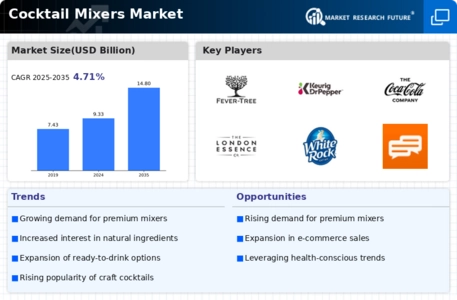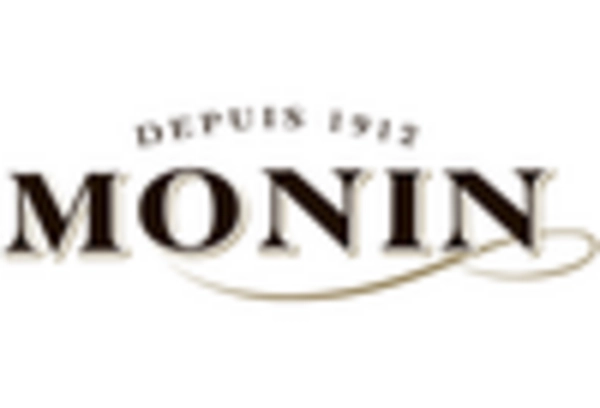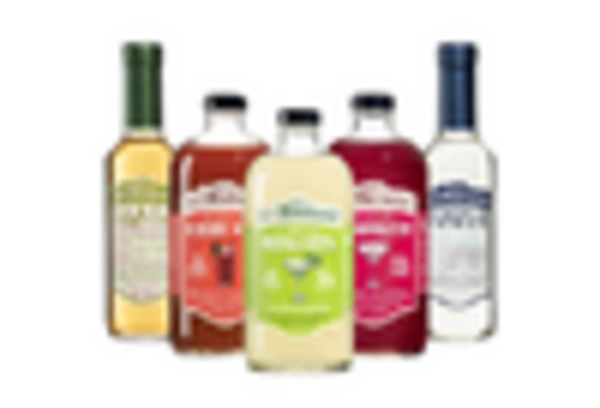-
EXECUTIVE SUMMARY 11
-
GLOBAL COCKTAIL MIXERS MARKET, BY PRODUCT TYPE 13
-
GLOBAL COCKTAIL MIXERS MARKET, BY DISTRIBUTION CHANNEL 14
-
GLOBAL COCKTAIL MIXERS MARKET, BY REGION 15
-
MARKET INTRODUCTION 16
-
DEFINITION 16
-
SCOPE OF THE STUDY 16
-
SCOPE OF THE STUDY 16
-
MARKET STRUCTURE 17
-
RESEARCH METHODOLOGY 18
-
RESEARCH PROCESS 18
-
PRIMARY RESEARCH 19
-
SECONDARY RESEARCH 20
-
MARKET SIZE ESTIMATION 20
-
TOP DOWN & BOTTOM-UP APPROACH 21
-
FORECAST MODEL 22
-
LIST OF ASSUMPTIONS 23
-
MARKET DYNAMICS 24
-
DRIVERS 24
- GROWING DEMAND FOR LOW-ALCOHOL COCKTAILS ASSOCIATED WITH HEALTH CONSCIOUSNESS DRIVES THE MARKET GROWTH 24
- INCREASING PARTYING AMONG MILLENNIALS 25
- DRIVER IMPACT ANALYSIS 26
-
RESTRAINTS 26
- DEMAND FOR JUICES WITH ENERGY DRINKS AND BOTANICAL INGREDIENTS 26
- RESTRAINT IMPACT ANALYSIS 27
-
OPPORTUNITIES 27
- INCREASING PRODUCT INNOVATIONS SEASONAL AND HOLIDAYS AND WEATHER CONDITIONS 27
-
CHALLENGES 28
-
MARKET FACTOR ANALYSIS 29
-
VALUE/SUPPLY CHAIN ANALYSIS 29
- RAW MATERIALS 30
- MANUFACTURING PROCESS 30
- DISTRIBUTION 30
- END USER 31
-
PORTER’S FIVE FORCES MODEL 31
- THREAT OF NEW ENTRANTS 32
- BARGAINING POWER OF SUPPLIERS 32
- THREAT OF SUBSTITUTES 32
- BARGAINING POWER OF BUYERS 32
- INTENSITY OF RIVALRY 33
-
IMPACT OF COVID-19 ON THE GLOBAL COCKTAIL MIXERS MARKET 33
- IMPACT ON SUPPLY CHAIN 34
- IMPACT ON PRODUCTION 34
-
GLOBAL COCKTAIL MIXERS MARKET, BY PRODUCT TYPE 35
-
OVERVIEW 35
-
TONIC WATER 36
-
CLUB SODA 36
-
GINGER 37
-
OTHERS 38
-
GLOBAL COCKTAIL MIXERS MARKET, BY DISTRIBUTION CHANNEL 39
-
OVERVIEW 39
-
ON-TRADE 39
-
OFF-TRADE 40
-
GLOBAL COCKTAIL MIXERS, BY REGION 41
-
OVERVIEW 41
-
NORTH AMERICA 42
- US 44
- CANADA 44
- MEXICO 45
-
EUROPE 46
- GERMANY 47
- FRANCE 48
- ITALY 49
- SPAIN 49
- UK 50
- REST OF EUROPE 51
-
ASIA-PACIFIC 52
- CHINA 53
- JAPAN 54
- INDIA 55
- AUSTRALIA & NEW ZEALAND 55
- REST OF ASIA PACIFIC 56
-
REST OF THE WORLD 57
- SOUTH AMERICA 58
- MIDDLE EAST 59
- AFRICA 60
-
COMPETITIVE LANDSCAPE 61
-
COMPETITIVE OVERVIEW 61
-
MAJOR GROWTH STRATEGY IN THE GLOBAL COCKTAIL MIXERS MARKET 61
-
COMPETITIVE BENCHMARKING 63
-
COMPANY PROFILES 64
-
FEVER-TREE 64
- COMPANY OVERVIEW 64
- FINANCIAL OVERVIEW 65
- PRODUCTS OFFERED 65
- KEY DEVELOPMENTS 66
- SWOT ANALYSIS 67
- KEY STRATEGIES 67
-
KEURIG DR PEPPER 68
- COMPANY OVERVIEW 68
- FINANCIAL OVERVIEW 69
- PRODUCTS OFFERED 70
- KEY DEVELOPMENTS 70
- SWOT ANALYSIS 71
- KEY STRATEGIES 71
-
THE COCA-COLA COMPANY 72
- COMPANY OVERVIEW 72
- FINANCIAL OVERVIEW 73
- KEY PRODUCTS 73
- KEY DEVELOPMENTS 74
- SWOT ANALYSIS 74
- KEY STRATEGIES 75
-
FENTIMANS 76
- COMPANY OVERVIEW 76
- FINANCIAL OVERVIEW 76
- PRODUCTS OFFERED 76
- KEY DEVELOPMENTS 77
- SWOT ANALYSIS 77
- KEY STRATEGIES 78
-
THE LONDON ESSENCE COMPANY 79
- COMPANY OVERVIEW 79
- FINANCIAL OVERVIEW 79
- PRODUCTS OFFERED 79
- KEY DEVELOPMENTS 80
- SWOT ANALYSIS 80
- KEY STRATEGIES 81
-
WHITE ROCK BEVERAGES 82
- COMPANY OVERVIEW 82
- FINANCIAL OVERVIEW 82
- PRODUCTS OFFERED 82
- KEY DEVELOPMENTS 82
- SWOT ANALYSIS 83
- KEY STRATEGIES 83
-
THREE CENTS 84
- COMPANY OVERVIEW 84
- PRODUCTS OFFERED 84
- KEY DEVELOPMENTS 84
-
EAST IMPERIAL 85
- COMPANY OVERVIEW 85
- PRODUCTS OFFERED 85
- KEY DEVELOPMENTS 85
-
BICKFORD & SONS 86
- COMPANY OVERVIEW 86
- PRODUCTS OFFERED 86
- KEY DEVELOPMENTS 86
-
SEPOY & CO 87
- COMPANY OVERVIEW 87
- KEY PRODUCTS 87
- KEY DEVELOPMENTS 87
-
-
LIST OF TABLES
-
LIST OF ASSUMPTIONS 23
-
GLOBAL COCKTAIL MIXERS MARKET ESTIMATES & FORECAST, BY PRODUCT TYPE, 2023-2030 (USD MILLION) 35
-
TONIC WATER: MARKET ESTIMATES & FORECAST, BY REGION, 2023-2030 (USD MILLION) 36
-
CLUB SODA: MARKET ESTIMATES & FORECAST, BY REGION, 2023-2030 (USD MILLION) 37
-
GINGER: MARKET ESTIMATES & FORECAST, BY REGION, 2023-2030 (USD MILLION) 37
-
OTHERS: MARKET ESTIMATES & FORECAST, BY REGION, 2023-2030 (USD MILLION) 38
-
GLOBAL COCKTAIL MIXERS MARKET ESTIMATES & FORECAST, BY DISTRIBUTION CHANNEL, 2023-2030 (USD MILLION) 39
-
ON-TRADE: MARKET ESTIMATES & FORECAST, BY REGION, 2023-2030 (USD MILLION) 40
-
OFF-TRADE: MARKET ESTIMATES & FORECAST, BY REGION, 2023-2030 (USD MILLION) 40
-
GLOBAL COCKTAIL MIXERS MARKET ESTIMATES & FORECAST, BY REGION, 2023-2030 (USD MILLION) 42
-
NORTH AMERICA: MARKET ESTIMATES & FORECAST, BY COUNTRY, 2023-2030 (USD MILLION) 43
-
NORTH AMERICA COCKTAIL MIXERS MARKET ESTIMATES & FORECAST, BY PRODUCT TYPE, 2023-2030 (USD MILLION) 43
-
NORTH AMERICA COCKTAIL MIXERS MARKET ESTIMATES & FORECAST, BY DISTRIBUTION CHANNEL, 2023-2030 (USD MILLION) 43
-
US COCKTAIL MIXERS MARKET ESTIMATES & FORECAST, BY PRODUCT TYPE, 2023-2030 (USD MILLION) 44
-
US COCKTAIL MIXERS MARKET ESTIMATES & FORECAST, BY DISTRIBUTION CHANNEL, 2023-2030 (USD MILLION) 44
-
CANADA COCKTAIL MIXERS MARKET ESTIMATES & FORECAST, BY PRODUCT TYPE, 2023-2030 (USD MILLION) 44
-
CANADA COCKTAIL MIXERS MARKET ESTIMATES & FORECAST, BY DISTRIBUTION CHANNEL, 2023-2030 (USD MILLION) 45
-
MEXICO COCKTAIL MIXERS MARKET ESTIMATES & FORECAST, BY PRODUCT TYPE, 2023-2030 (USD MILLION) 45
-
MEXICO COCKTAIL MIXERS MARKET ESTIMATES & FORECAST, BY DISTRIBUTION CHANNEL, 2023-2030 (USD MILLION) 45
-
EUROPE: MARKET ESTIMATES & FORECAST, BY COUNTRY, 2023-2030 (USD MILLION) 46
-
EUROPE COCKTAIL MIXERS MARKET ESTIMATES & FORECAST, BY PRODUCT TYPE, 2023-2030 (USD MILLION) 47
-
EUROPE COCKTAIL MIXERS MARKET ESTIMATES & FORECAST, BY DISTRIBUTION CHANNEL, 2023-2030 (USD MILLION) 47
-
GERMANY COCKTAIL MIXERS MARKET ESTIMATES & FORECAST, BY PRODUCT TYPE, 2023-2030 (USD MILLION) 47
-
GERMANY COCKTAIL MIXERS MARKET ESTIMATES & FORECAST, BY DISTRIBUTION CHANNEL, 2023-2030 (USD MILLION) 48
-
FRANCE COCKTAIL MIXERS MARKET ESTIMATES & FORECAST, BY PRODUCT TYPE, 2023-2030 (USD MILLION) 48
-
FRANCE COCKTAIL MIXERS MARKET ESTIMATES & FORECAST, BY DISTRIBUTION CHANNEL, 2023-2030 (USD MILLION) 48
-
ITALY COCKTAIL MIXERS MARKET ESTIMATES & FORECAST, BY PRODUCT TYPE, 2023-2030 (USD MILLION) 49
-
ITALY COCKTAIL MIXERS MARKET ESTIMATES & FORECAST, BY DISTRIBUTION CHANNEL, 2023-2030 (USD MILLION) 49
-
SPAIN COCKTAIL MIXERS MARKET ESTIMATES & FORECAST, BY PRODUCT TYPE, 2023-2030 (USD MILLION) 49
-
SPAIN COCKTAIL MIXERS MARKET ESTIMATES & FORECAST, BY DISTRIBUTION CHANNEL, 2023-2030 (USD MILLION) 50
-
UK COCKTAIL MIXERS MARKET ESTIMATES & FORECAST, BY PRODUCT TYPE, 2023-2030 (USD MILLION) 50
-
UK COCKTAIL MIXERS MARKET ESTIMATES & FORECAST, BY DISTRIBUTION CHANNEL, 2023-2030 (USD MILLION) 50
-
REST OF EUROPE COCKTAIL MIXERS MARKET ESTIMATES & FORECAST, BY PRODUCT TYPE, 2023-2030 (USD MILLION) 51
-
REST OF EUROPE COCKTAIL MIXERS MARKET ESTIMATES & FORECAST, BY DISTRIBUTION CHANNEL, 2023-2030 (USD MILLION) 51
-
ASIA-PACIFIC: MARKET ESTIMATES & FORECAST, BY COUNTRY, 2023-2030 (USD MILLION) 52
-
ASIA PACIFIC COCKTAIL MIXERS MARKET ESTIMATES & FORECAST, BY PRODUCT TYPE, 2023-2030 (USD MILLION) 53
-
ASIA PACIFIC COCKTAIL MIXERS MARKET ESTIMATES & FORECAST, BY DISTRIBUTION CHANNEL, 2023-2030 (USD MILLION) 53
-
CHINA COCKTAIL MIXERS MARKET ESTIMATES & FORECAST, BY PRODUCT TYPE, 2023-2030 (USD MILLION) 53
-
CHINA COCKTAIL MIXERS MARKET ESTIMATES & FORECAST, BY DISTRIBUTION CHANNEL, 2023-2030 (USD MILLION) 54
-
JAPAN COCKTAIL MIXERS MARKET ESTIMATES & FORECAST, BY PRODUCT TYPE, 2023-2030 (USD MILLION) 54
-
JAPAN COCKTAIL MIXERS MARKET ESTIMATES & FORECAST, BY DISTRIBUTION CHANNEL, 2023-2030 (USD MILLION) 54
-
INDIA COCKTAIL MIXERS MARKET ESTIMATES & FORECAST, BY PRODUCT TYPE, 2023-2030 (USD MILLION) 55
-
INDIA COCKTAIL MIXERS MARKET ESTIMATES & FORECAST, BY DISTRIBUTION CHANNEL, 2023-2030 (USD MILLION) 55
-
AUSTRALIA & NEW ZEALAND COCKTAIL MIXERS MARKET ESTIMATES & FORECAST, BY PRODUCT TYPE, 2023-2030 (USD MILLION) 55
-
AUSTRALIA & NEW ZEALAND COCKTAIL MIXERS MARKET ESTIMATES & FORECAST, BY DISTRIBUTION CHANNEL, 2023-2030 (USD MILLION) 56
-
REST OF ASIA PACIFIC COCKTAIL MIXERS MARKET ESTIMATES & FORECAST, BY PRODUCT TYPE, 2023-2030 (USD MILLION) 56
-
REST OF ASIA PACIFIC COCKTAIL MIXERS MARKET ESTIMATES & FORECAST, BY DISTRIBUTION CHANNEL, 2023-2030 (USD MILLION) 56
-
REST OF THE WORLD: MARKET ESTIMATES & FORECAST, BY COUNTRY, 2023-2030 (USD MILLION) 57
-
REST OF THE WORLD COCKTAIL MIXERS MARKET ESTIMATES & FORECAST, BY PRODUCT TYPE, 2023-2030 (USD MILLION) 58
-
REST OF THE WORLD COCKTAIL MIXERS MARKET ESTIMATES & FORECAST, BY DISTRIBUTION CHANNEL, 2023-2030 (USD MILLION) 58
-
SOUTH AMERICA COCKTAIL MIXERS MARKET ESTIMATES & FORECAST, BY PRODUCT TYPE, 2023-2030 (USD MILLION) 58
-
SOUTH AMERICA COCKTAIL MIXERS MARKET ESTIMATES & FORECAST, BY DISTRIBUTION CHANNEL, 2023-2030 (USD MILLION) 59
-
MIDDLE EAST COCKTAIL MIXERS MARKET ESTIMATES & FORECAST, BY PRODUCT TYPE, 2023-2030 (USD MILLION) 59
-
MIDDLE EAST COCKTAIL MIXERS MARKET ESTIMATES & FORECAST, BY DISTRIBUTION CHANNEL, 2023-2030 (USD MILLION) 59
-
AFRICA COCKTAIL MIXERS MARKET ESTIMATES & FORECAST, BY PRODUCT TYPE, 2023-2030 (USD MILLION) 60
-
AFRICA COCKTAIL MIXERS MARKET ESTIMATES & FORECAST, BY DISTRIBUTION CHANNEL, 2023-2030 (USD MILLION) 60
-
FEVERTREE DRINKS PLC.: PRODUCTS OFFERED 65
-
FEVERTREE DRINKS PLC: KEY DEVELOPMENTS 66
-
KEURIG DR PEPPER.: PRODUCTS OFFERED 70
-
KEURIG DR PEPPER: KEY DEVELOPMENTS 70
-
THE COCA-COLA COMPANY: PRODUCTS OFFERED 73
-
THE COCA-COLA COMPANY: KEY DEVELOPMENTS 74
-
FENTIMANS: PRODUCTS OFFERED 76
-
FENTIMANS: KEY DEVELOPMENTS 77
-
LONDON ESSENCE: PRODUCTS OFFERED 79
-
LONDON ESSENCE: KEY DEVELOPMENTS 80
-
WHITE ROCK BEVERAGES: PRODUCTS OFFERED 82
-
THREE CENTS.: PRODUCTS OFFERED 84
-
EAST IMPERIAL: PRODUCTS OFFERED 85
-
BICKFORD & SONS: PRODUCTS OFFERED 86
-
SEPOY & CO: PRODUCTS OFFERED 87
-
-
LIST OF FIGURES
-
MARKET SYNOPSIS 12
-
GLOBAL COCKTAIL MIXERS MARKET ANALYSIS, BY PRODUCT TYPE, 2023 13
-
GLOBAL COCKTAIL MIXERS MARKET, BY PRODUCT TYPE, 2023-2030 (USD MILLION) 13
-
GLOBAL COCKTAIL MIXERS MARKET ANALYSIS, BY DISTRIBUTION CHANNEL, 2023 14
-
GLOBAL COCKTAIL MIXERS MARKET, BY DISTRIBUTION CHANNEL, 2023-2030 (USD MILLION) 14
-
GLOBAL COCKTAIL MIXERS MARKET ANALYSIS, BY REGION, 2023 15
-
GLOBAL COCKTAIL MIXERS MARKET: STRUCTURE 17
-
RESEARCH PROCESS OF MRFR 18
-
DROC ANALYSIS OF GLOBAL COCKTAIL MIXERS MARKET 24
-
DRIVER IMPACT ANALYSIS 26
-
RESTRAINT IMPACT ANALYSIS 27
-
VALUE/SUPPLY CHAIN: GLOBAL COCKTAIL MIXERS MARKET 29
-
PORTER''S FIVE FORCES ANALYSIS OF THE GLOBAL COCKTAIL MIXERS MARKET 31
-
GLOBAL COCKTAIL MIXERS MARKET, BY PRODUCT TYPE, 2023 (% SHARE) 35
-
GLOBAL COCKTAIL MIXERS MARKET, BY DISTRIBUTION CHANNEL, 2023 (% SHARE) 39
-
GLOBAL COCKTAIL MIXERS MARKET, BY REGION, 2023 (% SHARE) 41
-
GLOBAL COCKTAIL MIXERS MARKET, BY REGION, 2023-2030(USD MILLION) 41
-
NORTH AMERICA: COCKTAIL MIXERS SHARE, BY COUNTRY, 2023 (% SHARE) 42
-
EUROPE: COCKTAIL MIXERS SHARE, BY COUNTRY, 2023 (% SHARE) 46
-
ASIA-PACIFIC: COCKTAIL MIXERS SHARE, BY COUNTRY, 2023 (% SHARE) 52
-
REST OF THE WORLD: COCKTAIL MIXERS SHARE, BY COUNTRY, 2023 (% SHARE) 57
-
FEVERTREE DRINKS PLC.: FINANCIAL OVERVIEW SNAPSHOT 65
-
FEVERTREE DRINKS PLC.: SWOT ANALYSIS 67
-
KEURIG DR PEPPER.: FINANCIAL OVERVIEW SNAPSHOT 69
-
KEURIG DR PEPPER.: SWOT ANALYSIS 71
-
THE COCA-COLA COMPANY.: FINANCIAL OVERVIEW SNAPSHOT 73
-
THE COCA-COLA COMPANY: SWOT ANALYSIS 74
-
FENTIMANS: SWOT ANALYSIS 77
-
LONDON ESSENCE: SWOT ANALYSIS 80
-
WHITE ROCK BEVERAGES: SWOT ANALYSIS 83'










Leave a Comment